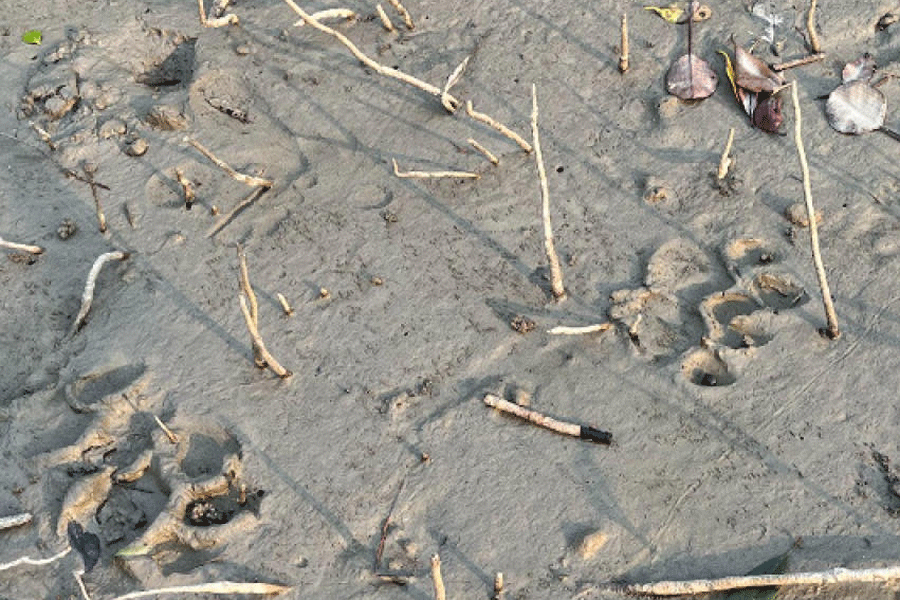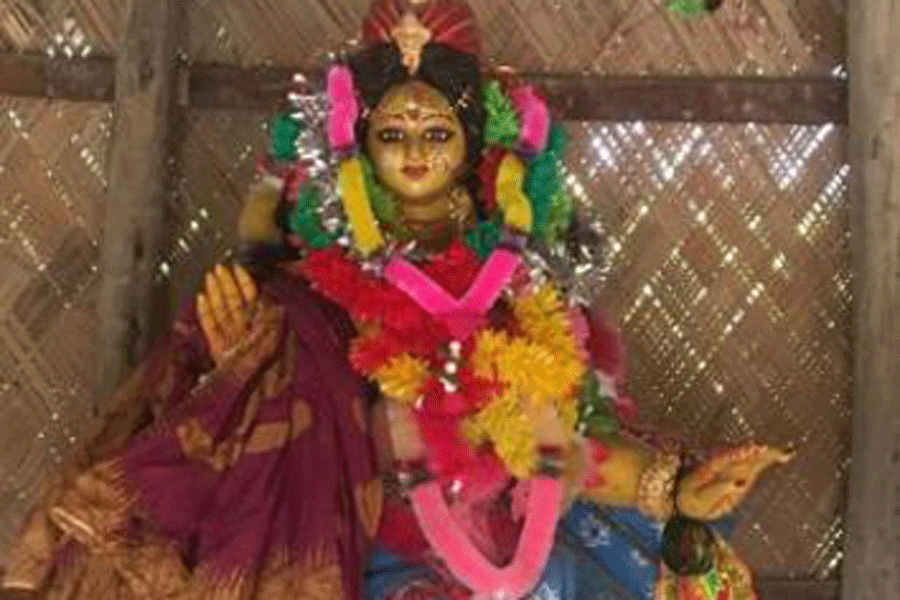Residents of Kalitala-Samshernagar in Hingalganj block in the Sunderbans are very happy with a recent gift from the chief minister: a brand new temple of Bonbibi, the forest goddess.
The temple is all marble and tiles, with the light shining off its polished surfaces, and it is expected that the chief minister will inaugurate it soon. The people of Hingalganj are waiting eagerly for the occasion.
But one wonders what Bonbibi would have made of her new home. The oldest of the temples of Bonbibi, who is worshipped as the protector of all creatures from the dangers of the forest, especially from the tiger, were built decades ago — at the very least — and are a far cry from the marble-and-tile structure that is the Hingalganj temple.
In the interiors of the Sunderbans, Bonbibi temples can look like survivors from another time.
Of late, Bonbibi’s popularity has travelled far beyond the Sunderbans, even into Coke Studio as a song — one reason, perhaps, behind the idea that she deserves
a “modern” home even in the Sunderbans.
In the forest area of Kultali is located an old Bonbibi temple that is visited frequently by local residents and outsiders. Kultali is one of the places in the Sunderbans where tigers are being sighted in increasing numbers now. Every year, on the last Tuesday of the Bengali month of Baisakh, a Bonbibi mela is organised. The occasion draws thousands of people, including Hindus and Muslims, as Bonbibi is revered by both communities.
According to her story, which lives on in many versions and is also sung by her devotees as Bonbibir gaan, she defeats Dakshin Ray, the tiger god of the Sunderbans, and at once takes over the Sunderbans and saves the people from Dakshin
Ray, who, too, continues to be worshipped.
Getting to the temple is not easy. One has to go by boat, down a hauntingly beautiful, serene green-blue stream that flows into River Matla, which reigns wide and sweeping against the horizon. To get to the boat is not easy either; the slope of the mudbanks is treacherous. An untrained urban body can disappear swiftly into its depths if not supported by able hands. My friend and I are being taken to the temple by Kamal Bera, a fisherman who lives in a village in Mai-pith area of Kultali.

Pugmarks of the tiger leading to the temple. Chandrima S. Bhattacharya
Bera has absolute faith in Bonbibi. He starts out every day, or night, as it may be, into the perilous waters and forests by taking Bonbibi’s name. To her, he owes his
survival, he says. We are in his small diesel-driven fishing boat. With him is his helper. On both sides of the blue-green water are mangrove forests. On the way, we pick up Rabin Guchchhait, who does the puja at the Bonbibi temple.
Like Guchchhait, often Bonbibi’s priests are not Brahmins. “Eta amader gorib jele-bauleder pujo… This is the puja of us, the poor jele-baule community,” says Guchchhait. “We do not know any mantras.”
We get down at a spot that marks the beginning of Bonbibi’s “thaan” (from sthaan, or place). My heart skips a few beats as I look down. Pugmarks are all around us. Clear large ones and smaller smudged ones mark the length of the narrow path that leads from the mudbank to the temple, our destination.
“That mark is old, from a few days earlier, but this one is from this morning,” says Bera. “Eta Bonbibir thaan. This is where the tigers will come,” he says. “All you have to do is have faith in Bonbibi,” he says.
This is the sanctum sanctorum. Tigers roam here, Bera seems to say, but they are rendered powerless by the goddess. Bera’s father, a fisherman like him, was killed by a tiger. Guchchhait says he once rescued someone from the tiger’s jaws. They have lost count how many times they have seen a tiger. The number of tigers is growing significantly now, they say. But no tiger ever attacks at the thaan, they insist. Their grandfathers, who had migrated to the Sunderbans from Midnapore, had built the temple, they say.
The temple is a revelation. It is a large, beautiful, spare, mud structure supported by bamboo poles. Its only concession to modern age is the tin roof. The inside is bare, except for eight, rather grand, idols in a row. In the middle, on the right side, is Bonbibi. One of the best-dressed goddesses, she is wearing a sari here, though sometimes she can also be seen wearing a ghagra and salwar. But her headdress is like that of a Muslim princess. She has an enchanting, heart-shaped face, a bright yellow complexion and looks on benignly at what stretches ahead of her: the river and the forest. To her left is Shah Jangali, her brother. Next to him are Boro Gaji Khan Saheb, a king, says Guchchhait, and Peer Saheb, his minister. Peer Saheb is also known as Chhawal Peer, one who blesses people with children.
Guchchhait performs the worship of these four, who are of Muslim origin, during the festival. The puja is performed simply, without any mantra, just by offering Bonbibi and her companions some food and flowers. To Bonbibi’s right are four “Hindu” goddesses, says Guchchhait: Narayani Debi, Dakshin Ray’s mother, riding a tiger here, Ma Bishalakshi, very similar to Kali, Ma Manasa, the goddess of snakes, and Ma Ganga,
the river goddess, with Makar, her vahana. Their puja, during the same festival, is performed by a Hindu Brahmin priest.
This very pantheon should be enough as an ans-wer to the peddlers of communal politics, who are now also trying to appropriate Dakshin Ray as “Hindu” and alienating “Bonbibi” as Muslim, as temples take centre stage. “Devotees turn up in thousands to attend the festival, both Hindus and Muslims,” says Guchchhait.
Bonbibi’s story is also an interesting reference to a period in Bengal’s history. According to Munsi Baynaddi’s kechchha-kabya (narrative poems in praise of a deity’s accomplishments), Bonbibi Jahuranama, Bonbibi and her brother Shah Jangali had come over from Mecca to rule over Badaban, or the Sunderbans, points out Gopendrakrishna Basu in his book Banglar Loukik Debata. In a parallel account, Bonbibi defeats Dakshin Ray to rescue Dukhe, a poor youth who was tricked by his relatives into being sacrificed for Dakshin Ray. Some Bonbibi idols have her carrying Dukhe, like a child, on her lap.
In the last few years, Bonbibi’s popularity has grown spectacularly, outside the Sunderbans and into popular culture. The goddess got global recognition since
Amitav Ghosh wrote The Hungry Tide, his novel set in the Sunderbans. Since then, she has appeared in a Bengali film and also in Coke Studio, where she is rather unre- cognisable as a pretty young, slim woman with a tall headdress moving to fusion beats.
All this has not changed Bera’s life. He has to go fishing every day, sometimes in the dead of night, though he has stopped catching crabs, which takes one to the interiors of the forest. Many deaths occur from tiger attacks when men go to collect crabs or honey. Bera also farms and manages a fishery, and yet finds it hard to make both ends meet. “I hardly sleep,” he says. Neither does his wife, who works by his side all day long and also manages the household, though she does not go fishing.
Having faith is the only way to survive. “You will meet the tiger,” says Bera. “And you can never trust him. Only if you can look into the tiger’s eye, you can win. But how many can do that? So you have to have faith in Bonbibi,” he says. At this point, Guchchhait expresses his heart’s desire. “We also want to construct a concrete temple here,” he says.
Thankfully the forest department has stopped this effort so far. But in this age
of temples, we do not know for how long.










